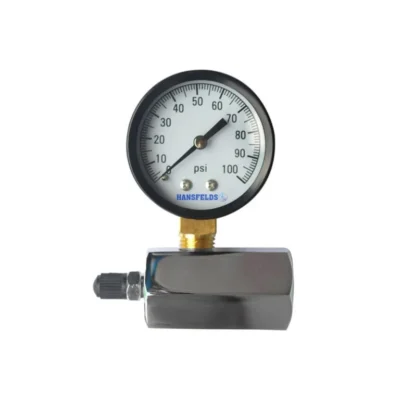CNG pressure gauge
0-400bar / 5800psi
CNG pressure gauge size: 2 ″, 2.5 ″
Thread: 1/8 ″, 1/4 ″, 3/8 ″ 1/2 ″ BSP, NPT, BSPT or on request
Applications:
Used for pneumatic systems
Compressors, compressed air system
CNG pressure gauge
Suitable for liquid media that do not clog the connection or corrode the copper alloy.
Housing: black steel (black lacquered steel, chrome-plated steel, ABS)
Ring: No (black steel, black lacquer steel, chrome-plated steel)
Windows: Acrylic (glass, acrylic, polycarbonate)
Socket & connection: brass
Movement: half brass (completely brass)
Bourdon tube: copper alloy (brass)
Hands and dial: aluminum
Range: vacuum, compound 0 to 6000 psi accuracy
Class: F ± 3/2/3% (ASME B40.100 grade B)
Kl 2.5 FOR 1 1/2 ″, 2 ″, Kl 1.6 FOR 2 1/2 ″, 3 ″, 4 ″
Environment: -40 ° F to 140 ° F (-40 ℃ TO 60 ℃)
Media: 140 ° F (+ 60 ℃) maximum
Because of this, these vehicles are allowed on roads where others are not. Hansfeld’s measuring devices are used to display the level of compressed (CNG) or liquefied (LNG) natural gas in a tank
The cost and placement of fuel storage containers is the main barrier to wider / faster adoption of CNG as a fuel. This is also why local government and public transportation were the most visible early adopters, as they can amortize the money invested in the new (and usually cheaper) fuel faster. Despite these circumstances, the number of vehicles with CNG has grown steadily worldwide (30 percent per year). [
Comparison with other natural gas fuels
Compressed natural gas is often confused with LNG (Liquefied Natural Gas). Both are stored forms of natural gas. The main difference is that CNG is stored at ambient temperature and high pressure, while LNG is stored at low temperature and near ambient pressure. Under the respective storage conditions, LNG is a liquid and CNG is a supercritical fluid. Compared to LNG, CNG has lower production and storage costs because it does not require an expensive cooling process or cryotanks. However, CNG requires a much larger volume to store the energy equivalent of gasoline and the use of very high pressures (3000 to 4000 psi or 205 to 275 bar). For this reason, LNG is often used to transport natural gas over long distances in ships, trains or pipelines, where the gas is converted to CNG before being distributed to the end user.
Natural gas is experimentally stored at lower pressure in a form known as an ANG (Adsorbed Natural Gas) bottle, where it is adsorbed in various sponge-like materials at 35 bar (500 psi, the pressure of gas in natural gas pipelines). such as carbon [20] and MOFs (organometallic frameworks). [21] The fuel is stored with a similar or higher energy density than CNG. This means that vehicles can be refueled from the natural gas network without additional gas compression, the fuel bottles can be slimmed down and made from lighter, weaker materials.

















